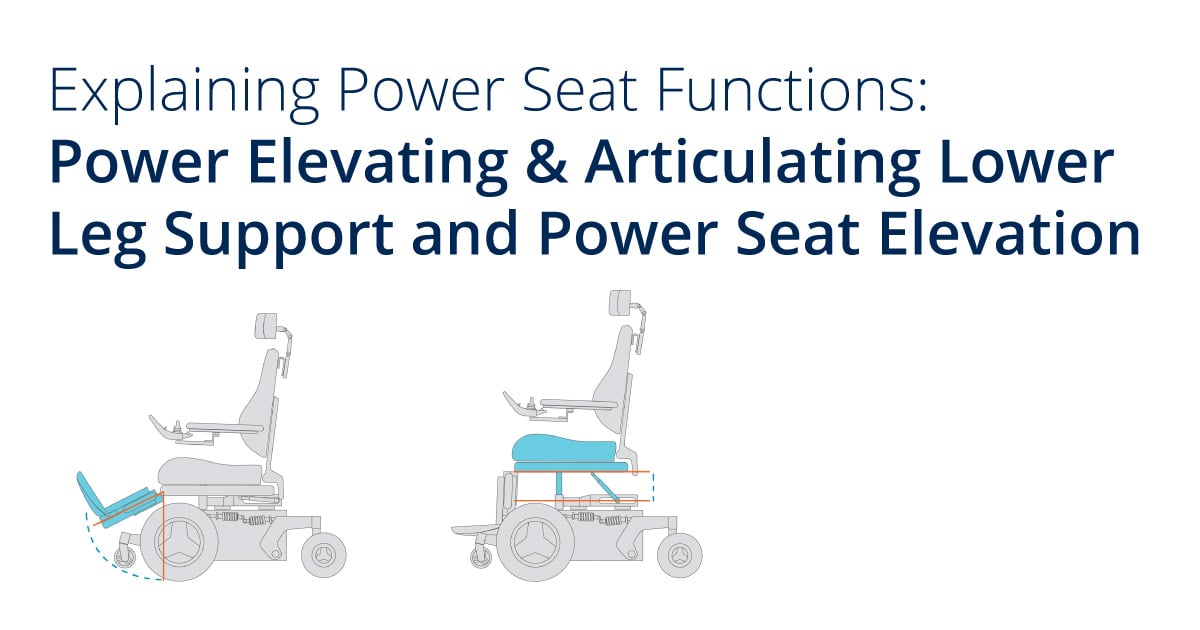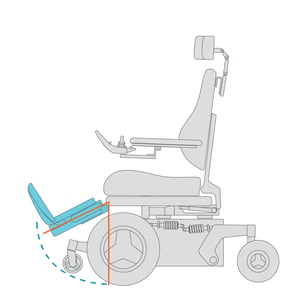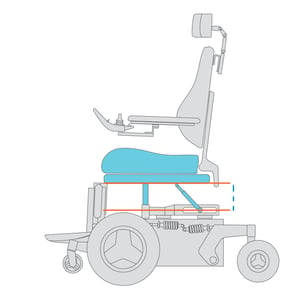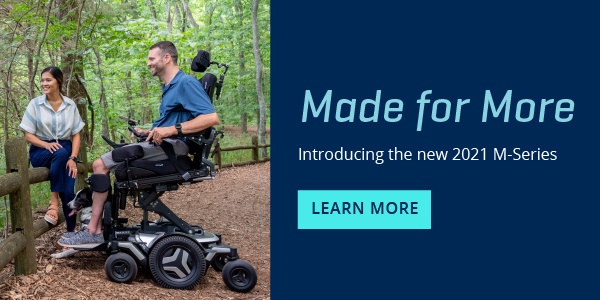Power Elevating and Articulating Lower Leg Support
| Definitions | Clinical benefits may include |
|
Allow clients to change the seat to lower leg support angle in order to flex or extend the knee. Some legrests articulate, that is, lengthen while extending the knee.
|
When legs are fully elevated, along with the use of tilt and recline, lower extremity edema can be managed |
|
When using tilt and/or recline functions, legs can be positioned to achieve optimal pressure distribution |
|
|
Use with recline to aid in maintenance of pelvic position (prevention of posterior or anterior pelvic tilt) |
|
|
Pain management |
|
|
Articulation aids in maintenance of distal thigh loading on the cushion for pressure distribution and prevents the end user from shifting out of position (Dicianno et al., 2009) |
|
|
Articulation aids with maintaining appropriate position in seating system when used with power standing |
|
* If using elevating lower leg supports to extend the knee, strongly consider using in conjunction with power recline in order to prevent a posterior pelvic tilt, given the hamstring is a two-joint muscle. |
Power Wheelchair Seat Elevation
| Definitions | Clinical benefits may include |
|
Power seat elevation "allows raising and lowering the whole seating system, changing the seat to floor height without altering the angular orientation of the seating supports" (Waugh & Crane, 2014, p. 48)
|
The ability to reach higher surfaces to complete MRADLs |
|
Protect upper extremities by reducing the risk of repetitive strain injury related to overhead reaching |
|
|
Perform job tasks that would be impossible in a standard height WC |
|
|
Help improve safety and independence with transfers |
|
|
Allows eye contact with others while reducing risk of cervical strain |
|
|
Provides psycho-social benefits of being on peer level and speaking face-to-face |
|
|
Promotes enhanced safety with increased visibility while maneuvering wheelchair in the community |
Permobil uses the term ActiveHeight™ when referring to seat elevation.
|
* When seat elevation is combined with anterior tilt, it provides a more natural and front-facing approach to a task. Benefits may include:
|
References:
Dicianno, B. E., Arva, J., Lieberman, J. M., Schmeler, M. R., Souza, A., Phillips, K., Lange, M., Cooper, R., Davis, K. & Betz, K. L. (2009). RESNA position on the application of tilt, recline and elevating legrests for wheelchairs. Assistive Technology, 21(1) 13-22.
Waugh, K. & Crane, B. (2013). Glossary of wheelchair terms and definitions, Version 1.0. Assistive Technology Partners.
 Stacey Mullis, OTR/ATP
Stacey Mullis, OTR/ATP
Director of Clinical Marketing
Stacey serves as Director of Clinical Marketing for Permobil. A practicing OTR for over 20 years, she has experience in school-based pediatrics, inpatient rehabilitation, long term care, and home health. With her interest in wheelchair seating and positioning, Stacey engaged the challenges of providing appropriate seating in various clinical settings. She now uses this experience to develop programs and resources to educate clinicians on the principles of seating and wheeled mobility. She is passionate about equipping clinicians and through her previous role as Director of Clinical Education with Comfort Company and now with Permobil she has taught nationally and internationally to increase therapist capacity in this specialty area. Mullis graduated from Western University in London, Ontario, Canada with a BA Linguistics and BSc Occupational Therapy. She is a member of the NCOTA, CTF Executive Board, NRRTs, RESNA, and AOTA.
 Angela Regier, OTD, OTR/L, ATP/SMS
Angela Regier, OTD, OTR/L, ATP/SMS
Clinical Education Manager
Angela Regier, OTD, OTR/L, ATP received her doctorate of occupational therapy from Creighton University in 2007 and is a RESNA-certified assistive technology professional. Regier joined Permobil in 2017 as a Clinical Education Manager for the western region. Prior to joining Permobil, Regier was at Craig Hospital in Englewood, Colorado where her career focused on inpatient and outpatient spinal cord injury rehabilitation. Prior to leaving Craig Hospital, she was supervisor of the Wheelchair Seating and Mobility Clinic where she provided comprehensive seating and mobility interventions for individuals with acquired brain and spinal cord injury. Regier has published and speaks on the topic of seating and mobility for acquired brain injury and spinal cord injury. She has also served as an adjunct faculty for the Creighton University Entry-Level Distance OTD Program (Regis) in Denver, Colorado.



